I’ve been hunting whitetail deer for several years now, and frankly, although I remember all the hunts, some of the details have faded over time. I don’t think the details of this hunt, my first mule deer hunt, will ever leave. It started strangely and as you’ll see, ended in a way I could never have imagined.
Remington Outdoor Company’s PR and PA person, Jessica Kallam, and I traveled deep past the heart of Texas for this hunt last December. I flew into Atlanta, met Eric Poole (editor at Guns & Ammo) and Jessica, caught a hop to El Paso, and rented a Dodge Charger – a fun car to drive, but a poor chariot to take us on the 4-hour trek into a Texas-style blizzard. After a long drive on rocky country roads, we eventually made it to the A.S. Gage Ranch, in the Chihuahuan Desert of West Texas, after passing through a border patrol checkpoint.

Check out this view from inside the main ranch house.
It turned-out to be worth the drive, as the accommodations, food, and most importantly to us, guide services seemed primo. Operated by Wildlife Systems, Inc., this ranch is part of a network of outstanding hunting ranches in the state. In fact, Jessica and I had bagged our limit of doves at another ranch in the system, back in September, near San Angelo.

Here I am with the Remington Model 700 Magpul, braving the sleet and cold to get my shots on target. (Jessica Kallam photo)
After a delicious steak dinner (and really, is there better beef in the world than Texas beef?) we asked our guides if we could sight in our rifles, even though the clock showed it closing in on 10 p.m. Although the guides looked at us like maybe we were a little crazy – since now we had a sleet storm blowing icy particles horizontally and dropping the temperature – they agreed to set up the 100-yard-range, and pointed the headlights of their trucks downrange at the targets.

Without the can, the Model 700 in the Magpul version.
We would be shooting Remington Model 700 Magpul rifles with AAC silencers – yes, believe it or not, we’d hunt with cans – the SR7s; Eric chose the one chambered in 6.5 Creedmoor, which left the 2 chambered in 308 Win for Jess and me.
This Model 700 comes with a carbon steel barreled action, tactical bolt handle and threaded muzzle with thread protector. It offers a super crisp trigger, and right away, the former Marine (aka, Eric) liked its form and function. It has the wonderful Magpul Hunter stock with an aluminum bedding block, which is adjustable. Finished in black Cerakote, this is a gun to sling and then, reach out and touch what you want to touch on Western hunts, such as this one.
We shot Barnes VOR-TX ammo (130 grain tipped TSX BT) and worked with our Leupold VX-5HD scopes. After I was able to 3 rounds that produced a 1 inch group – within record time for me, fortunately – Eric gave me a great tip and told me to photograph the scope’s elevation and windage settings with my cell phone – just in case the scope got bumped or reset somehow. Little did I know at the time how important that tip would be, and the similar lesson I would learn later?
I also made a note on my phone to myself with the scope’s settings, too.
The next day, my guide and I crawled around the ranch in a huge Ford truck, traversing what felt like most of its 190,000-acres, looking for a buck at least 5 years and preferably 7 years old, since this was a managed hunt to cull the old guys. In frigid, below freezing weather, we slipped along icy roads that made for an interesting day with lots of glassing.

Mike glasses to check the ages of bucks on a mountainside.
My guide, Mike, and I hit it off instantly. In fact, we liked a lot of the same things, including the “Dead Cowboy” music (found on a Sirius XM™ station) in the truck. Mike also looks the iconic Texas Ranger/Lonesome Dove character, with Texas-size stories in abundance that made the time pass quickly. One thing that brought home to me how important it is to have the right binoculars happened when he pointed out the difference between a yucca with snow on it and a mule deer with its backside to us, which believe it or not was difficult to discern. His expensive Swarovski 15×56 SLC binos beat my Nikon Monarch in 8×42 handily, stressing the importance of getting the right power and best quality of binos that you can afford for the job.
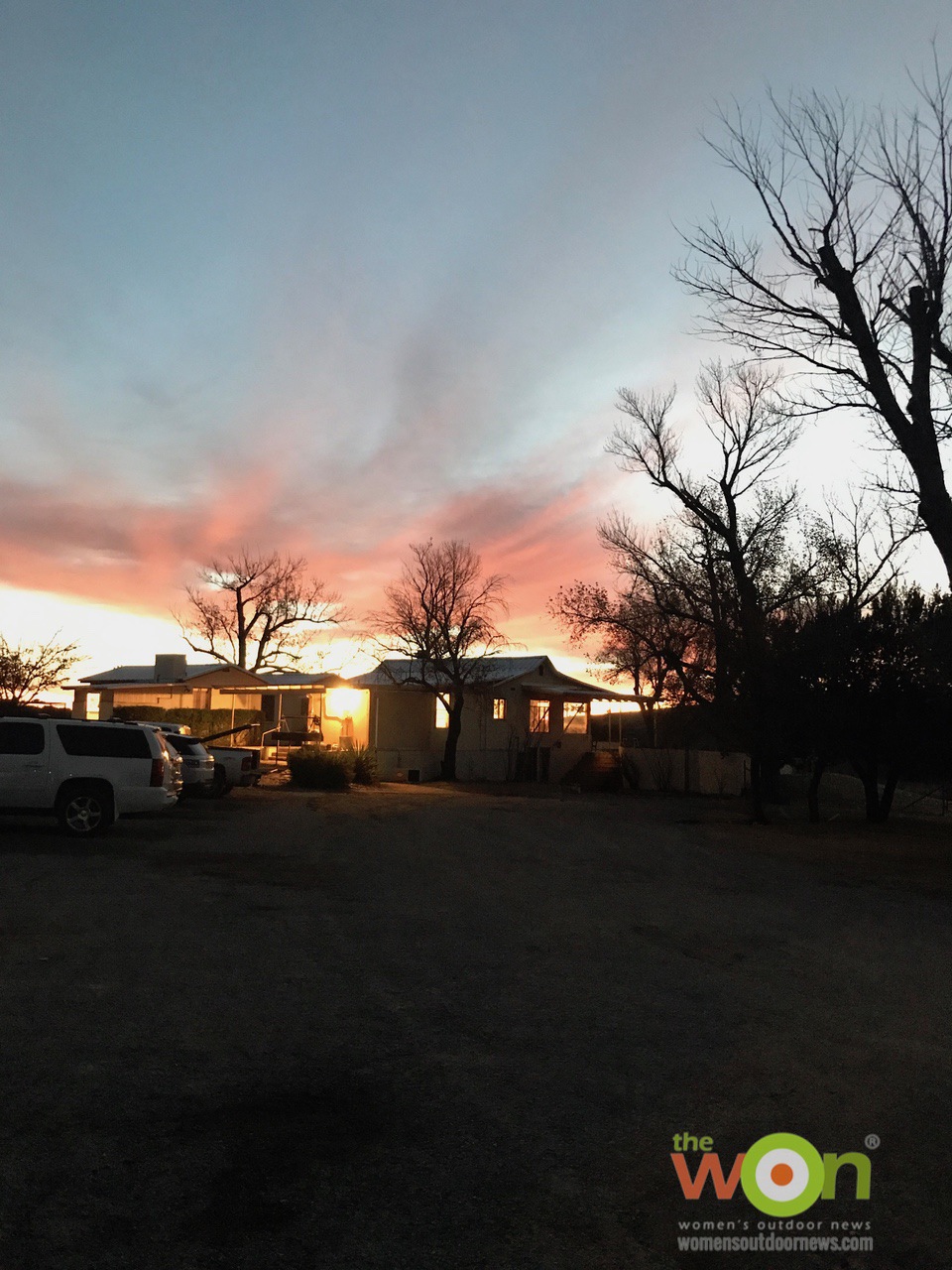
The AS Gage Ranch on our last morning.
The Remington hunters weren’t the only hunters in camp and on that day, no one brought in a tagged muley. The next day, with the sun shining, Mike and I returned to his portion of the ranch and started glassing. We saw at least 100 young bucks, and several does. We spent the morning wearing our eyes out, checking antler width and points, head and body sizes.
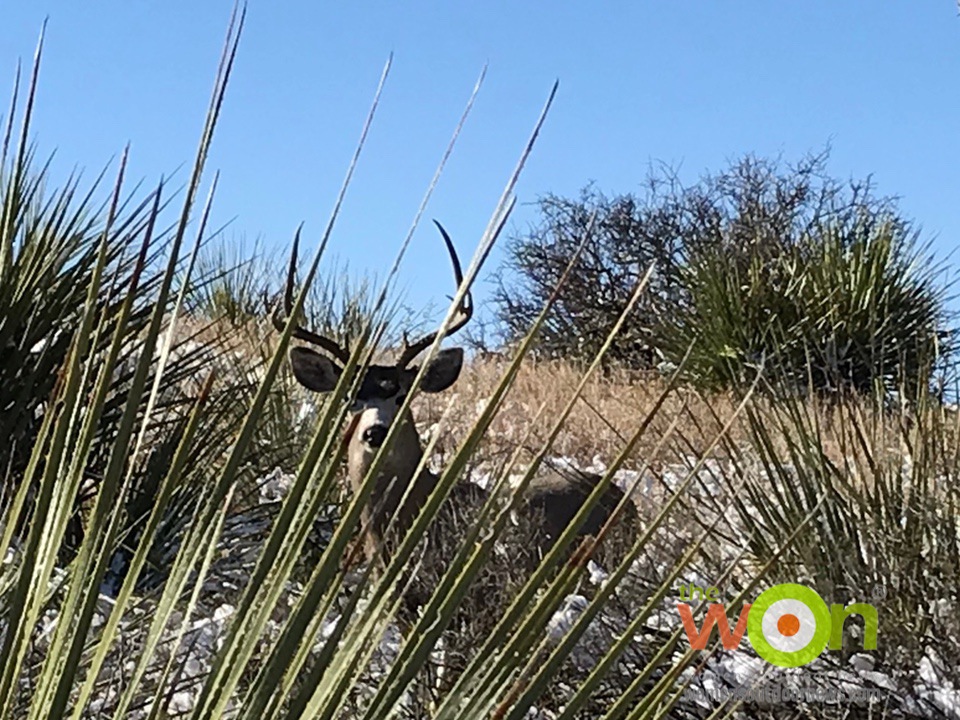
This guy was too young to consider.
After a while, I could count on hearing one of these reasons from Mike for not pursuing a buck:
Then, we rounded a corner at the base of a mountain ridge, and there before me stood not a yucca plant, but a big buck. Mike declared, and I will never forget, “Barb, that ain’t no yucca butt!”
 Game on.
Game on.
We waited for the deer, who stood about 200 yards away, to fully lift his head and let us see his features. He qualified easily, in Mike’s book. I snuck around the truck with my gun, got it positioned across the hood of the truck and put the dinner plate area of that buck – now at 178 yards – into the crosshairs of my scope. One shot. “You missed clean,” said Mike, scratching his head. “Take another shot.” The deer stood there. I set up the second shot, and “Whap.”
“You took a tine clean off!” exclaimed Mike, and that buck just shook his head like, “What the heck?”
At this point, I checked the scope again. I knew the gun – pointed upright without a round in the chamber, a policy dictated by the outfitter for truck travel – had at one time slipped between the passenger seat and the door – but I had wound the scope settings back to the noted numerals. Or so, I thought.
I would never risk practicing adjusting a scope on an animal. Mike offered me his trusty Remington 700 that his dad had just used in Wyoming on an elk, chambered in 30.06 and zeroed. By this time, the deer suspected that these folks over by the truck had something deadly in mind, and started sauntering off to the west. I grabbed Mike’s rifle and he took the shooting sticks and we started stalking.
That old buck did not hurry, yet we searched for him for at least half an hour. Mike spotted him hiding in a mesquite bush. Mike quickly set up the rifle on the sticks, about 100 yards from the deer, and I took a shot.
The deer again sauntered off, away from us, but this time I knew I had heard the hollow thump of a good hit on a deer.
Mike went down to find the deer and called to me that the hunt was over and I knew that my shot had been a clean one, through the buck’s lungs.
Whew. That is always a relief.

Can you tell which tine we “restored” for photos? If you said the one my the left nearest to me, you got it right. (Michael Lassig photo)
We also circled back to see if we might find the missing tine – no luck. After field-dressing the deer, and putting it into the walk-in freezer at the ranch, we took the Magpul rifle back out to the range. At this point, I had no confidence in that particular rifle/scope set up. What had just happened back there? It turns out, my shots at 100 and 200 yards now fell at least 2 feet or higher above the middle of each target. The scope’s elevation had changed, even though the settings matched what I had noted as being the correct ones when I first sighted-in the rifle.
Eric examined the scope, declared something in the elevation adjustment had broken. Lesson learned here. Always bring a back-up gun on an important hunt, if possible.
Thankfully, my guide had a trusty Remington 700 with him, and now that gun has another notch in its stock – my first muley, aged about 7 years. I donated the meat to a family in the area, and the Euro-mount will hang in my office. When I look up at it, I’ll think of that first foray into Texas desert muley hunting, and how it taught me yet another lesson in deer hunting.
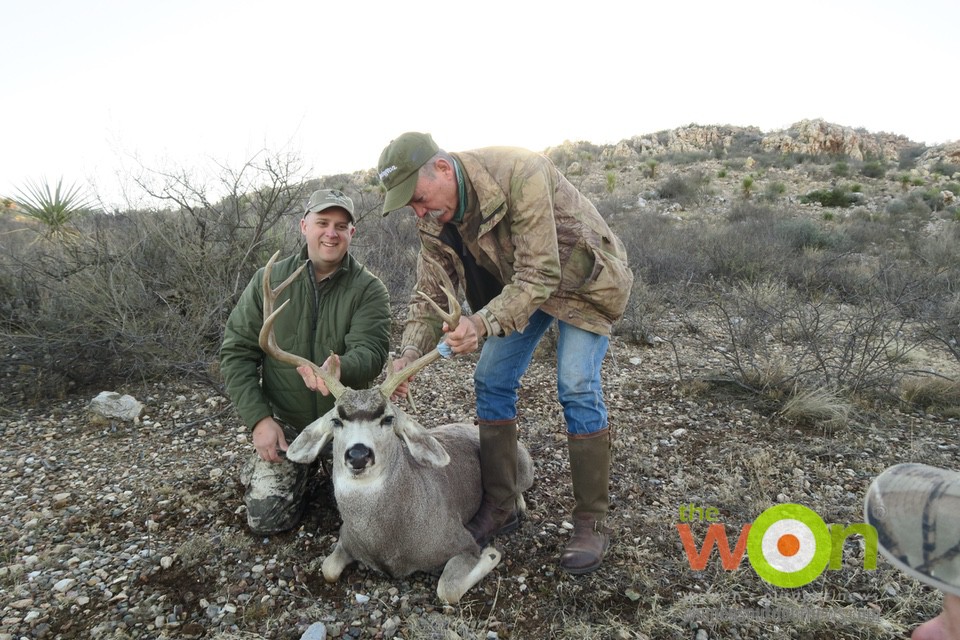
The next day, Mike and I accompanied Eric Poole and his guide. Eric tagged this buck with an easy 100-yard shot, after a short walk-up to it.
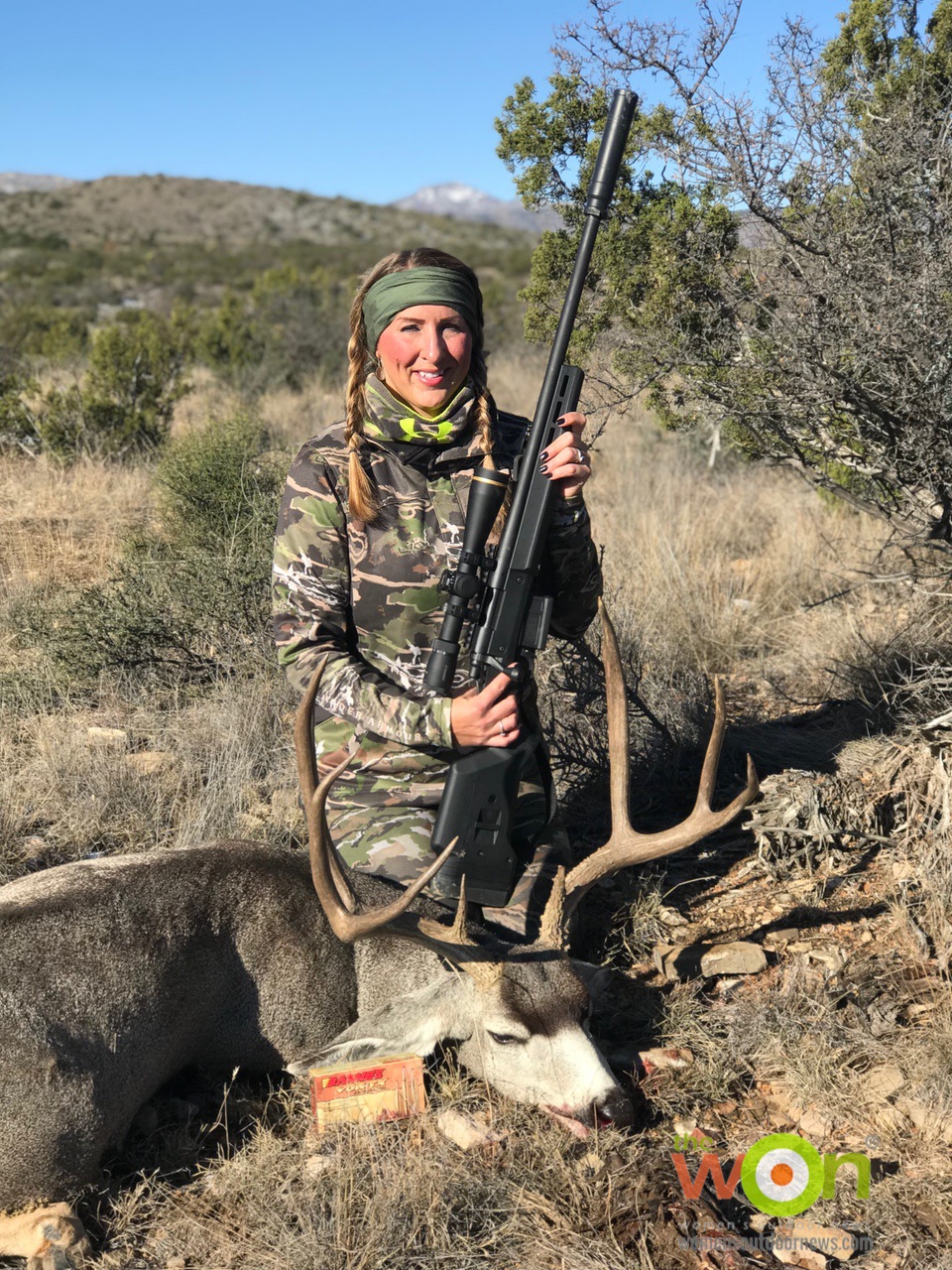
And then, it was Jessica Kallam’s turn to tag the oldest of the 3 taken on our hunt.
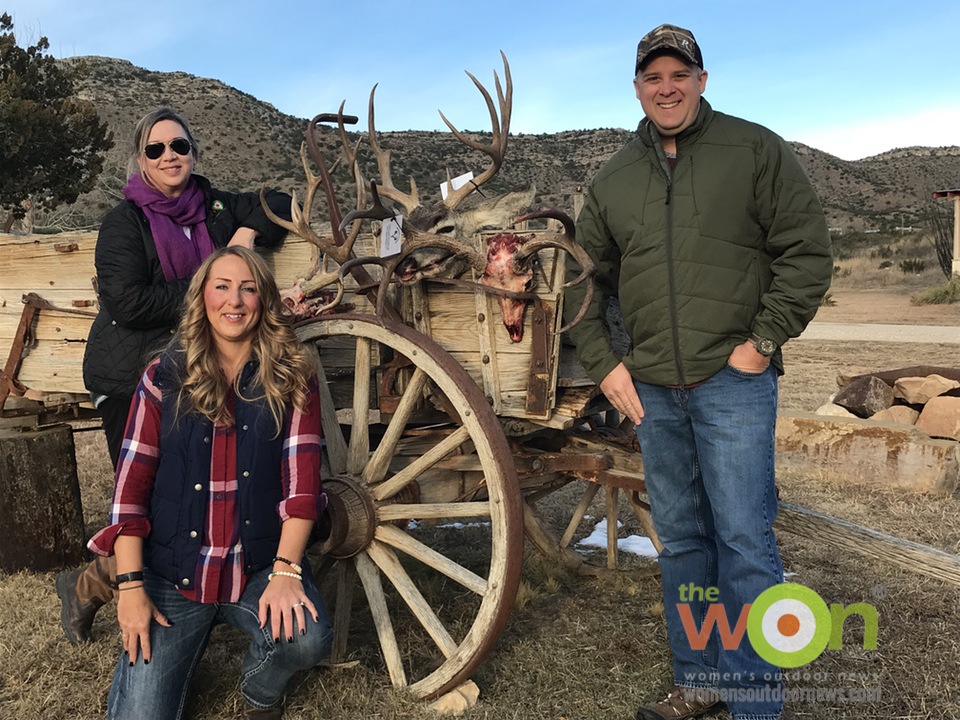
We all chose European mounts for our bucks, and before we left for the airport, we took one last photo of this beautiful ranch, and our lovely mounts and tried to capture our good time together.
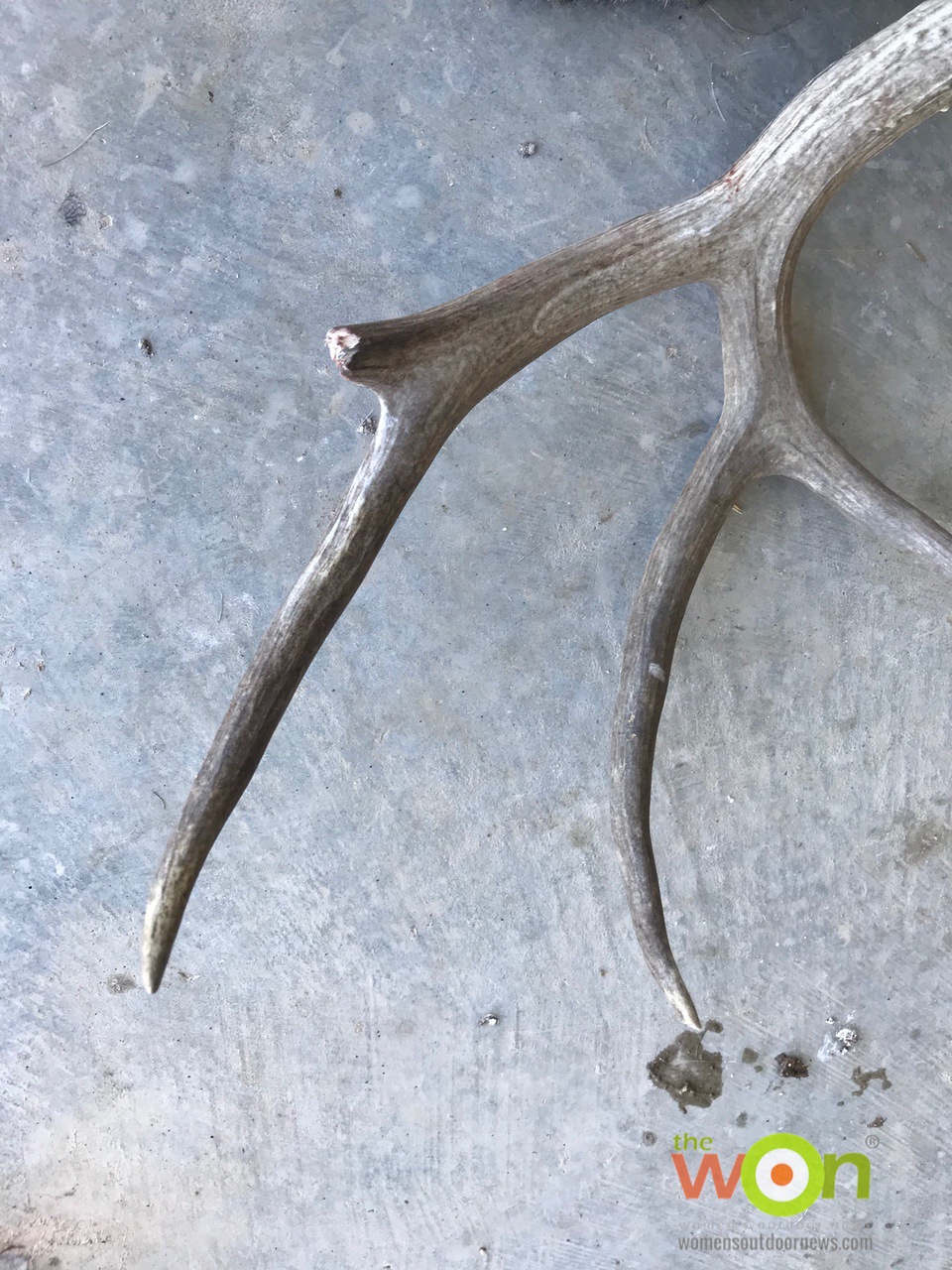
Just in case you’ve read this far … this is what the antler sans a tine looked like.
Publisher/Editor Barbara Baird is a freelance writer in hunting, shooting and outdoor markets. Her bylines are found at several top hunting and shooting publications. She also is a travel writer, and you can follow her at https://www.ozarkian.com. View all posts by Barbara Baird